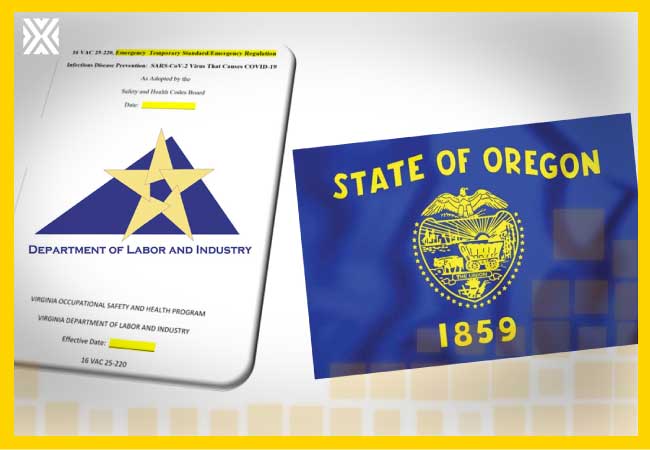Currency
August 30, 2020

Oregon has proposed an emergency temporary standard for workplace coronavirus disease 2019 (COVID-19) transmission. While there is no federal workplace safety and health standard for coronavirus exposures, California has an airborne transmissible disease standard for certain workplaces, and Virginia approved an emergency temporary standard for COVID-19 in July.
If approved, Oregon’s standard would contain requirements that apply to all workplaces, with additional requirements for job duties involving close-contact work activities and healthcare tasks like direct patient care. The Oregon Occupational Safety and Health Administration (OSHA) is accepting public comments on its draft rule through September 7.
The temporary rule could take effect on September 14 and would remain in effect for 180 days.

Under the temporary rule, all employers in the state would be required to:
● Design both the workplace and work activities to eliminate the need for workers to be within 6 feet of another individual in order to fulfill their duties.
● Ensure that face coverings are worn if the employer can demonstrate that 6-foot separation is not practical while maintaining as much distance as practical.
● Face coverings must be worn by employees and other individuals whenever customers, contractors, or other visitors are present and a strict separation cannot be maintained, and they must be worn by employees working in office settings when not at their desk or seated in a conference room in addition to whenever 6-foot distancing cannot be reliably maintained between individuals (including in corridors, restrooms, elevators, and stairwells).
● When employees are transported in a motor vehicle for work purposes, the center points of the seats of passengers not part of the same household must be separated by at least 3 feet, and all individuals in the vehicle must wear face coverings.
● Face coverings must be worn when individuals are engaged in forceful exertion, singing, or shouting and they are not separated from other individuals to their front by at least 12 feet.
To meet the 6-foot distancing requirement, employers also can use an impermeable barrier that creates a “droplet buffer” and provides at least a 6-foot distance between the mouths of two individuals.
The temporary rule also would contain sanitation requirements. Employers must ensure that all high-contact surfaces used by multiple employees like cash registers, computers, door handles, drinking fountains, seatbelts, and telephones are thoroughly cleaned at the beginning of each shift. Shared equipment and frequently touched surfaces must be cleaned before use by another employee.
The employer also must ensure that employees have the supplies necessary and are able to use proper hand hygiene before and after using shared equipment or tools and before eating, drinking, applying cosmetics, or smoking.
At establishments with at least 25 employees at any time, the employer must designate one or more employees who will be responsible for identifying appropriate social distancing, proper face covering use, and sanitation measures and ensuring adopted policies are implemented.
The rule also would contain requirements for the medical removal of employees with COVID-19 symptoms, undergoing testing, or otherwise requiring isolation. Workers must be reassigned to duties that do not involve in-person contact whenever a medical provider or public health official recommends isolation or quarantine.
Reassignment must continue until the need no longer exists based on guidance from the medical provider or involved public health officials, but employees are entitled to return to their previous job duties once medical removal is no longer necessary.
The temporary requirements would be stricter for occupations like barbers, beauticians, massage therapists, hairdressers, makeup artists, and tattooing. Requirements would include exposure assessment plans, enhanced information and training, and enhanced sanitation.
The most stringent requirements would apply to direct patient care in healthcare facilities, emergency responders, and those transporting human remains or laboratory samples. Requirements would include infection control plans, covering tasks, and situations requiring personal protective equipment. Infection control plans must conform to policies and recommendations from the Oregon Health Authority regarding COVID-19.
If approved, Oregon’s standard would contain requirements that apply to all workplaces, with additional requirements for job duties involving close-contact work activities and healthcare tasks like direct patient care. The Oregon Occupational Safety and Health Administration (OSHA) is accepting public comments on its draft rule through September 7.
The temporary rule could take effect on September 14 and would remain in effect for 180 days.

Under the temporary rule, all employers in the state would be required to:
● Design both the workplace and work activities to eliminate the need for workers to be within 6 feet of another individual in order to fulfill their duties.
● Ensure that face coverings are worn if the employer can demonstrate that 6-foot separation is not practical while maintaining as much distance as practical.
● Face coverings must be worn by employees and other individuals whenever customers, contractors, or other visitors are present and a strict separation cannot be maintained, and they must be worn by employees working in office settings when not at their desk or seated in a conference room in addition to whenever 6-foot distancing cannot be reliably maintained between individuals (including in corridors, restrooms, elevators, and stairwells).
● When employees are transported in a motor vehicle for work purposes, the center points of the seats of passengers not part of the same household must be separated by at least 3 feet, and all individuals in the vehicle must wear face coverings.
● Face coverings must be worn when individuals are engaged in forceful exertion, singing, or shouting and they are not separated from other individuals to their front by at least 12 feet.
To meet the 6-foot distancing requirement, employers also can use an impermeable barrier that creates a “droplet buffer” and provides at least a 6-foot distance between the mouths of two individuals.
The temporary rule also would contain sanitation requirements. Employers must ensure that all high-contact surfaces used by multiple employees like cash registers, computers, door handles, drinking fountains, seatbelts, and telephones are thoroughly cleaned at the beginning of each shift. Shared equipment and frequently touched surfaces must be cleaned before use by another employee.
The employer also must ensure that employees have the supplies necessary and are able to use proper hand hygiene before and after using shared equipment or tools and before eating, drinking, applying cosmetics, or smoking.
At establishments with at least 25 employees at any time, the employer must designate one or more employees who will be responsible for identifying appropriate social distancing, proper face covering use, and sanitation measures and ensuring adopted policies are implemented.
The rule also would contain requirements for the medical removal of employees with COVID-19 symptoms, undergoing testing, or otherwise requiring isolation. Workers must be reassigned to duties that do not involve in-person contact whenever a medical provider or public health official recommends isolation or quarantine.
Reassignment must continue until the need no longer exists based on guidance from the medical provider or involved public health officials, but employees are entitled to return to their previous job duties once medical removal is no longer necessary.
The temporary requirements would be stricter for occupations like barbers, beauticians, massage therapists, hairdressers, makeup artists, and tattooing. Requirements would include exposure assessment plans, enhanced information and training, and enhanced sanitation.
The most stringent requirements would apply to direct patient care in healthcare facilities, emergency responders, and those transporting human remains or laboratory samples. Requirements would include infection control plans, covering tasks, and situations requiring personal protective equipment. Infection control plans must conform to policies and recommendations from the Oregon Health Authority regarding COVID-19.









